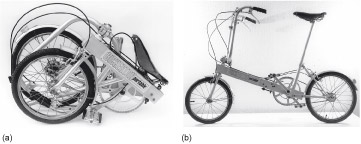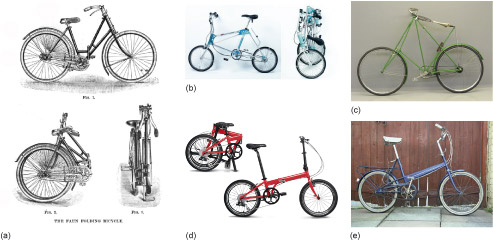2.2 Folding bicycles
Andrew Ritchie started designing a folding bicycle in 1975, stimulated by the Bickerton folding bicycle design. The Bickerton (Figure 20) is made from aluminium, and is hinged at the chainwheel bracket. This means that the chain and chainwheel are on the outside when the bicycle is folded, and the two wheels come together.
In essence, Ritchie was inspired by the thought that he could do better. His two major criticisms were that the bicycle didn't fold well because the chainwheel, the dirtiest part of a bicycle, was prominent; and that aluminium was not the best material for a folding bike.
Aluminium is too soft for a folding bicycle, it just doesn't stand up to the knocks, the everyday wear and tear.
The first criticism is easy to accept, but his view on aluminium is not at all obvious. After all, many bicycles are made from aluminium, which is a light, corrosion-resistant material, seemingly ideal for a portable bicycle. If it is good enough for major parts including frame and body panels of top-of-the-range cars like the Jaguar XJ and the new (at 2012) fourth generation Range Rover, why not for a bicycle also? Aluminium's corrosion resistance and low weight make it a good choice for automotive applications. Reducing body weight in a vehicle reduces carbon emissions through lower fuel consumption. In addition we notice that reducing the weight of the body has a number of knock-on effects including smaller brakes and smaller engine – which reduce weight even further – leading to a virtuous cycle of improving fuel performance.
In an established company an idea for a new product such as the Brompton would include other people in critical roles. For example, market researchers consulting with bicycle users estimate the size of the potential market. Designers with technical expertise in, say, frame design and structural analysis ensure viable, functioning designs. Cost would play a large part in the discussions, as would risk and the effect of the project on existing products and commitments to customers and suppliers. However, the story of the start of the Brompton did not involve this kind of backup. Ritchie was largely on his own at this point.
An independent designer can often find it difficult to get a sympathetic hearing when they take their ideas to established manufacturers. They face the 'not invented here' syndrome, where companies tend to put their faith in their own in-house ideas but cannot see the potential in ideas from outside. Alternatively, they see potential legal and economic problems in protecting and investing in a design that may have been shown to competitors. This is a common enough story: as you may be aware the Dyson vacuum cleaner was hawked around established vacuum cleaner companies who rejected the idea. Ritchie was to experience the same rejection from bicycle manufacturers.
His basic idea, which remained constant through the development of prototypes, was to hinge the bicycle to make the wheels come to the 'centre', one on each side of the chainwheel. In this way the wheels would shroud the oily chain and chainwheel.
Such a 'kinematic' solution (referring to the way that the parts of the bicycle move relative to each other) occupies a different design space from that of the Bickerton. It gives the same functional solution – reducing the length of the bike down to something that is more portable – but the way by which this is achieved is different. The concept of where the bicycle is hinged, and how its parts are arranged when folded is different. So how best to hinge the wheels? How can the neatest package be produced? What is the history of folding bikes and what can we learn from the labours of others?
Attempts to pack a bicycle into a convenient shape have a long and honourable history as told by Hadland and Pinkerton (1996) in their book It's in the Bag!: a History in outline of portable bicycles in the UK. They quote from Henry Sturmey's earlier book The Indispensible Bicyclist's Handbook first published in 1877:
The idea of putting a bicycle into a bag is, indeed, a queer one, but of considerable value for all that, in these days of high railway charges.
Figure 21 shows a collage of solutions to the problem of packing a bicycle. Common to all these designs is the problem of the protruding chainwheel so Ritchie's concept looks to be a genuine innovation.


